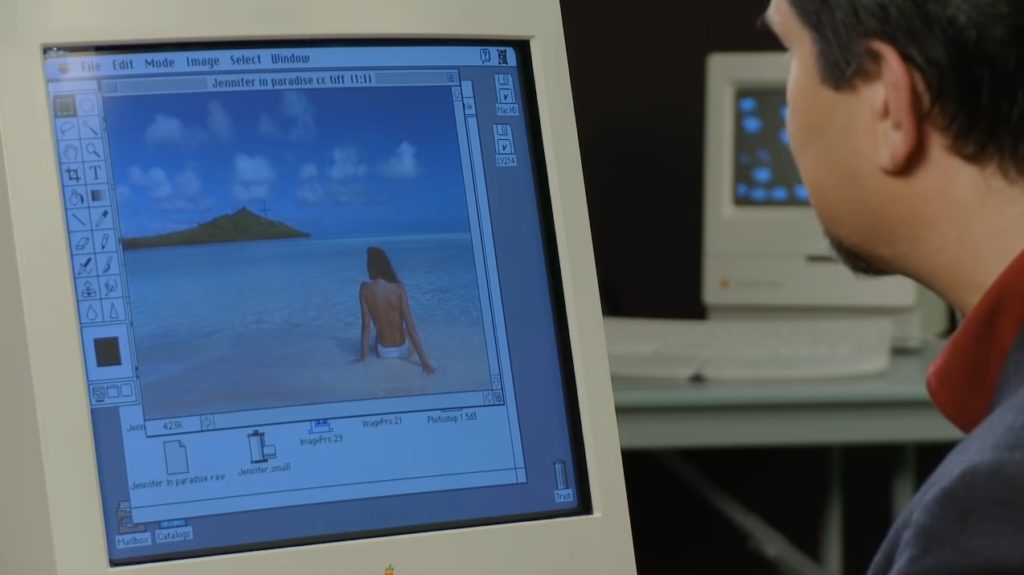
Very good question. And one for Quora, under any other circumstances.
Have you any idea what/who the subject of the first Photoshopped image was? (clue: it wasn’t a Kardashian)
Toughie, isn’t it?
Well, to help you try and work out just what the first Photoshopped image was, we’ve narrowed down the potential answers to this photo retouching-inspired conundrum to just three possibilities. And they are;
a. Photoshop co-creator, John Knoll’s future wife, Jennifer
b. Photoshop co-creator, John Knoll’s future wife, Jennifer
c. Photoshop co-creator, John Knoll’s future wife, Jennifer
That’s right, the answer is all three.
First Photoshopped Image was Jennifer in Paradise. There you Have It….
Jennifer who?
Not to put too finer (pixelled) point on it, a photo of a woman sat on a beach in Bora Bora in 1987 essentially became the crucial educational tool for the world (and their future wives) to manipulate images.
Who’d have ever imagined that what is, effectively an innocuous snap from a Tahiti holiday album would serve as the visual springboard for the birth of photo retouching as we know it today. Yeah, and technically enter the pantheons of online photo-enhancing editing history as the first Photoshopped image.
But it did, and this picture has itself been replicated many thousands of times since as part of would-be digital image manipulator’s learning curves.
Also, and in the guise of his Knoll’s then-girlfriend, we’re pretty sure that Jennifer herself wouldn’t have ever believed that such an innocent shot of her taking in a distant To’opua Island would have gone on to create such a photo editing phenomenon. Which, for the record, was a fleeting moment captured shortly before her future hubby proposed to her.

So, What’s the Story?
Having met as co-employees at Lucasfilm’s special effect arm, Industrial Light & Magic, the young lovebirds had enjoyed a well-earned break in the immediate aftermath of tirelessly working 70-hour weeks on a certain new film in the pipeline at the time. A movie going by the name of ‘Who Framed Roger Rabbit’.
You may have heard of it.
On returning from their holiday, Knoll became increasingly fascinated by a piece of kit he’d stumbled across at work. In a nutshell, this state-of-the-art hardware (referred to as the Pixar Image Computer) could take an image from film, scan it, translate it into digits and then manipulate said numericals and put it back out as a piece of film. As such, it was noted as amongt the first devices that could be facilitated to exploit images to this hitherto unseen degree.
However the were a few disadvantages, chief amongst which was the underlying fact that the Pixar machine cost hundreds of thousands of dollars and that due to its complexities only a specially-trained operator could master the image-processing/enhancing software.
But anyway – and to cut a long story short – in the meantime, John’s sibling, Thomas – a student of Computer Vision at the University of Michigan – had been bust developing favourably comparable software which could be utilized via the much more cost-effective, Apple Macintosh Plus.
You’ll Have to Remind Us, Where Does Jennifer Fit Into All This Then?
Image availability as a means of selling the concept of photo-editing software to interested parties/hedge funds in the early days. With precious few out-and-out digital images knocking around at the time, practical demonstrations of the capacity – and potential reach – of the fledgling software was well nigh impossible, as bids to impress investors were stepped up by the ambitious and entrepreneurial siblings.
Fast forward a few weeks, and during a visit to Apple’s Advanced Technology Group lab, the opportunity arose for John to showcase the fundamentals of his new image manipulating software. However the only photo he had to hand was that of his wife, captured on their hols. And there and then this relatively ordinary 6′ x 4′ print of ‘Jennifer in Paradise’ (as Knoll entitled it) went on to become the very first full colour image used to demonstrate the capacity of a piece of software which was for all intents and purpose, Photoshop in its most rudimentary form and function.
From thereon in Knoll would leave a copy of ‘Jennifer in Paradise’ as his visual calling card, whenever and wherever he hawked his pioneering software.
Jennifer X Thousands
It didn’t take long for cheeky programmers of the day to start cloning Jennifer, once the image gained traction in the industry as part and parcel of the game-changing software. And interest didn’t stop there, as Dutch artist, Constant Dullaart, created a montage from screenshots of the video and subsequently exhibited it as an art installation at his new London show. To his mind, he offered up his more creative interpretation of ‘Jennifer in Paradise’ as the original Photoshop meme; in a time before memes were a thing.
Was this yet another example of art imitating art?
John Knoll didn’t care, that’s for sure. Nor did he share the artist’s vision, going as far as to question his ethics and according to many, was almost apoplectic at the idea of someone reconstructing his treasured image without permission. And ironically, courtesy of (you guessed it) Photoshop. Jennifer, on the other hand, has remained less concerned and has since gone on record, reflecting; “The beauty of the internet is that people can take things, and do what they want with them, to project what they want or feel.”
